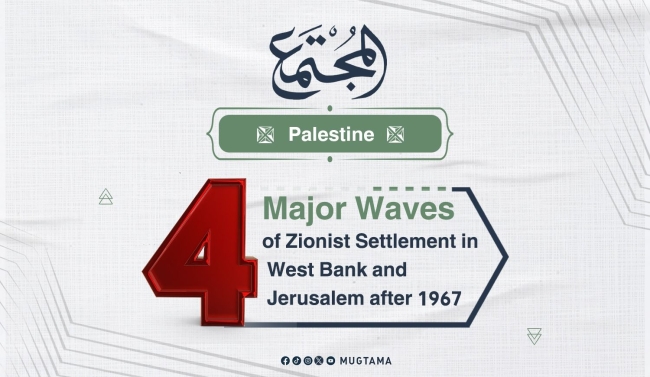4 Major Waves of Zionist Settlement in West Bank and Jerusalem after 1967
Since 1967, the West Bank and Jerusalem have experienced a series of settlement waves that have brought about profound changes to the region's geographic and political landscape. Despite the heavy defeat suffered by Arab states during that period, it did not lead to the mass displacement of Palestinians as occurred during the 1948 Nakba.
After occupying these territories, the Zionist occupation implemented expansionist strategies aimed at reducing the Palestinian population density and consolidating control by constructing new settlements and expanding existing ones.
These waves involve efforts to expand settlement areas by building new settlements and reinforcing control over the land through policies aimed at altering the demographic and geographical reality.
The settlement process has gone through several stages, each reflecting different government policies and strategic objectives, the most notable being:
1. The First Wave (1967-1976):
This began immediately after the occupation, with the occupation government aiming to assert control over Palestinian lands while avoiding the administration of Palestinian residents. This phase was marked by caution in building settlements and a focus on basic infrastructure.
About 34 settlements were established during this period. The occupation also demolished the Palestinian Mughrabi Quarter, which was adjacent to the Buraq Wall (Western Wall), converting it into a Jewish settlement area within the Old City. These steps aimed to consolidate the occupation’s control over the eastern part of the holy city.
2. The Second Wave (1977-1987):
With the rise of the right-wing to power in the Zionist entity in 1977, extremist forces aggressively pursued settlement construction, driven by ideological, security, political, and economic motives. This period saw the establishment of dozens of new settlements, accompanied by calls for the expulsion of Palestinians.
Ninety-eight new settlements were built in the West Bank during this period, most of them initiated by the ruling right-wing Likud party and the extremist religious Zionist movement "Gush Emunim," which was active in settlement activities.
3. The Third Wave (1996-2022):
This wave occurred during the political settlement process initiated in the 1990s, with the Zionist right seeking to obstruct any final agreements for fear of surrendering Palestinian lands and establishing an independent Palestinian state. During this phase, settlement construction accelerated to counter progress in negotiations.
The focus was on the comprehensive Judaization of Area C, which is under the occupation's security and administrative control according to the Oslo Accords and constitutes 60% of the West Bank's area. The aim was to create geographical continuity between remote settlements or between settlement blocs and to expand control over strategic hilltops in the West Bank. This wave resulted in significant geographical and demographic changes that supported the settlement project in the West Bank.
The settlements in this period were referred to by the Zionists as "unauthorized outposts," a misleading term intended to downplay the importance and magnitude of this settlement surge, which could be the largest among the settlement waves in the West Bank.
4. The Fourth Wave (2002):
This wave emerged after the failure of the peace process and the outbreak of the Second Palestinian Intifada in 2000. The Zionist leadership believed it was the right time to impose control over as much of the West Bank as possible. Thus, settlement expansion intensified, and Palestinian lands were fragmented into isolated cantons.
This wave took place under the control of right-wing factions in the occupation government. It began with Ariel Sharon, who led from 2001 to 2006, followed by Ehud Olmert (2006-2009), and then Benjamin Netanyahu (2009-2021). All of these leaders were prominent figures in the hardline Zionist right that actively sought to Judaize the West Bank.
These successive waves illustrate how the occupation sought to alter the geographical and political realities in the West Bank and Jerusalem, significantly impacting Palestinian lives and complicating the Arab-Israeli conflict.
-------------------------------------------------------------


